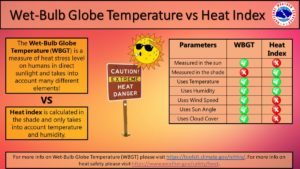Environmental parameters and personal factors influence one’s ability to transfer and store heat. However the weather report will report the ambient temperature (temperature of the air) or the the heat index (temperature and humidity), which are more limited means of reporting heat.
Using the Wet Bulb Heat Index, available through the National Weather Service weather.gov/TSA/WBGT, is considered the most comprehensive and safest means of reducing the risk of heat illness when planning for outdoor activities.


Having a neurological condition can make you more sensitive to heat. With some neurological conditions there is a lack of thermoregulation, and signs/symptoms of being overheated may not be as obvious. Certain medications can also affect sensitivity to heat.
How do you protect yourself against the heat and sun?
Planning outdoor activities during the cooler parts of the day is most ideal. The hottest part of the day tends to be between 11 am and 3 pm. Keeping the following points in mind may help your ability to continue safely enjoying the warm and sunny days!
Watch and protect your skin!
- Use sunscreen with appropriate SPF, protective clothing.
- Inspect your skin for burns and skin breakdown, watch changes in moles and freckles. Increased exposure to heat and moisture may cause heat rash or other means of skin irritation/breakdown.
Keep your area and items cool!
- Find a well ventilated place in the shade to get out of the direct sun. Examples: Umbrellas, pavilion, or tree covered area.
- Use of iced garments and towels, fans and skin wetting provide a localized cooling effect.
Stay hydrated and cool your skin!
- Drink 2000-3000 mL of water or 8-12 8-ounce cups of water per day, unless contraindicated by another health condition.
- Total immersion is generally the preferred method for substantial or quick cooling, such as a cool shower.
Know the symptoms of a heat stroke! Per the Centers for Disease Control and Prevention (CDC) seek medical attention immediately if you or someone experience these symptoms:
- Body temperature of 104°F or higher
- Altered mental state such as confusion, agitation, irritability, disorientation, delirium
- Altered behavior such as slurred speech, staggering
- Seizures, coma
- Alteration in sweat leading to dry skin
- Headache
- Dizziness or lightheadedness
- Nausea and/or vomiting
- Flushed or reddened skin
- Rapid or fast breathing and heart beat
- Muscle weakness or cramps
Most importantly, have a plan to avoid the extreme heat!
~ Dereck Chavis, MS OTR/L

